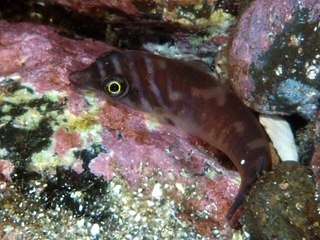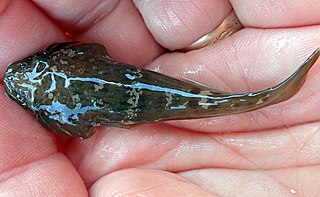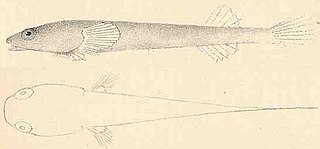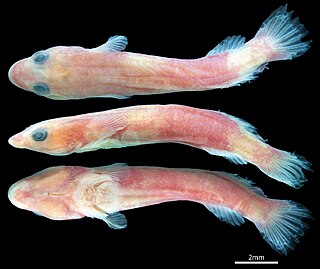The New Zealand urchin clingfish is a clingfish. It is found around New Zealand wherever sea urchins are present. Its length is between 2 and 3 cm.

Clingfishes are fishes of the family Gobiesocidae, the only family in the order Gobiesociformes. These fairly small to very small fishes are widespread in tropical and temperate regions, mostly near the coast, but a few species in deeper seas or fresh water. Most species shelter in shallow reefs or seagrass beds, clinging to rocks, algae and seagrass leaves with their sucking disc, a structure on their chest.
Dellichthys is a small genus of clingfishes from the family Gobiesocidae which are endemic to New Zealand. It had been regarded as a monotypic genus but a second species was described in 2018.
Hector's clingfish, Gastroscyphus hectoris, is a clingfish of the family Gobiesocidae, the only species in the genus Gastrocyathus. It is found all down the east coast of New Zealand around the low water mark amongst seaweed, on rocky coastlines. Its length is up to 6.4 centimetres (2.5 in) SL. This species was described in 1876 by Albert Günther as Crepidogaster hectoris from a holotype collected on the south shore of the Cook Strait. Günther honoured the Scottish-born scientist James Hector (1834-1907) who was the Director of the Geological Survey of New Zealand and who presented type to the British Museum.
The giant clingfish, Haplocylix littoreus, is a clingfish of the family Gobiesocidae, the only species in the genus Haplocylix. It is found all down the east coast of New Zealand around the low water mark amongst seaweed, on rocky coastlines. Its length is up to 15 centimetres (5.9 in). This species was originally described as Cyclopterus littoreus in 1801 by Johann Reinhold Forster, John C. Briggs subsequently placed it in the monotypic genus Haplocylix. Its closest relative appears to be the Caribbean deepwater clingfish Gymnoscyphus ascitus.

The New Zealand lumpfish is a clingfish of the family Gobiesocidae, found all around New Zealand including the Three Kings Islands, from low water to about 12 m, on rocky coastlines. Its length is up to 10 cm. This species was described as Lepadogaster pinnulatus by Johann Reinhold Forster in 1801 with a type locality of Queen Charlotte Sound, Marlborough Sounds off the South Island of New Zealand.

Acyrtus is a genus of clingfishes found in the western Atlantic Ocean.

Apletodon is a genus of marine fish in the family Gobiesocidae (clingfishes). The genus was first named by John Carmon Briggs in 1955.

Cochleoceps is a genus of clingfishes endemic to the waters around Australia.
Derilissus is a genus of clingfishes found in the western Atlantic Ocean.

Diplecogaster is a genus of fish in the family Gobiesocidae found in Black Sea, Mediterranean Sea and Atlantic Ocean.

Gobiesox is a genus of clingfishes found in the Americas, including offshore islands. Most species inhabit coastal marine and brackish waters, but G. lanceolatus is a deep-water species found at a depth of around 300 m (980 ft), and seven species are from fast-flowing rivers and streams. These seven are the only known freshwater clingfish.
Gymnoscyphus ascitus is a small species of clingfish found in the Caribbean Sea at depths of 231 to 318 m (758–1,043 ft). This species is the only known member of the genus Gymnoscyphus.

Kopua is a genus of clingfishes found in the Pacific Ocean.

Lepadogaster is a genus of clingfishes native to the eastern Atlantic Ocean extending into the Mediterranean Sea. Lepadogaster belongs to class Actinopterygii. This means that they share many of the same characteristics as eels, ray-finned fish, and sea horses to name a few. The main characteristic of all of them though is having fin rays. These fin rays are made of webbed skin and are attached to portions of the body that connect fins to the bones. Lepadogaster species have a distinct difference in the formation of their dorsal and anal fins. While most other ray-finned fish spines, branched fin-rays, and middle radials, Lepadogaster species do not have these. Instead, they have cartilage in place of the mentioned features. These clingfish are mainly found near the rocky coasts and inside intertidal zones. Lepadogaster is known mostly as a clingfish, meaning that it spends most of its time attached to the surface of rocks.
Pherallodiscus is a genus of clingfishes native to the central eastern Pacific Ocean along the coast of Mexico. Based on genetic studies the genus should be merged into Gobiesox.

Rimicola is a genus of clingfishes found along the coasts of the eastern Pacific Ocean.
Nettorhamphos radula, the duckbilled clingfish, is a species of clingfish from the Indian Ocean off Western Australia. It is currently the sole member of the genus Nettorhamphos.

Diplecogaster bimaculata, the two-spotted clingfish, is a species of fish in the family Gobiesocidae found in Black Sea, Mediterranean Sea and Atlantic Ocean where it is found on rocks and among seagrass or shell beds.

Flexor is a genus of clingfish from the family Gobiesocidae. It is a monotypic genus, the sole member of which Flexor incus was described in 2018 by Kevin W. Conway, Andrew L. Stewart and Adam P. Summers from type specimens collected on Raoul Island and L’Esperance Rock in the Kermadec Islands. An unknown species of clingfish was known to occur in the Kermadecs and it had been provisionally assigned to the genus Aspasmogaster but when examined the specimens proved to belong to a new genus which they name Flexor in reference to the flexibility of clingfishes and incus which means "anvil", a reference to the anvil like shape of the type locality, Raoul Island.











